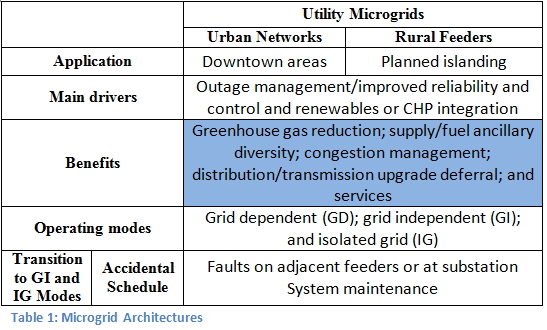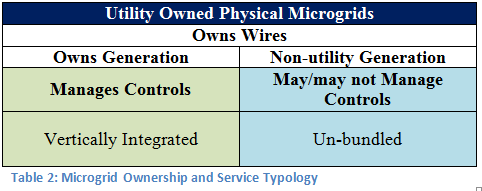Microgrid’s Advantages For Utility Company
–Cuiping Deng, Spring 2015
Microgrids are small-scale distribution systems that link distributed energy resources (DER) together with multiple local energy users and share supply resources by separate distribution facilities. Implementing microgrid systems can reduce energy costs, raise overall energy efficiency and improve environmental performance and local electric system reliability. The following is a list of the value streams of microgrids which are the features and benefits of microgrid system in different aspects, including economic, reliability and power quality, environmental, and security and safety.
Direct Economic Benefits:
- Reduced Energy Cost, able to sell excess power to the macro-grid
- Reduced purchases of electric generation, transmission and distribution (T&D) services
- Reduced fuel purchases for on-site thermal energy demand
- Reduced purchases of ancillary services, able to provide ancillary services to the macro-grid
- Participation in demand response programs
Indirect Economic Benefits:
- Reduced losses and deferred capacity investments of electric T&D
- Utility option value for long-term planning purposes
- Enhanced electricity price elasticity
- Support for deployment of renewable generation
Other Benefits:
- More Reliable: Reduced power interruptions
- Enhanced power quality
- Environmental friendly: Reduced emission of greenhouse gases and criteria pollutants
- Security and Safety: Provided safe havens during power outages
Microgrids can be classified by physical and virtual microgrid. Physical microgrids are small, local energy systems with integrated loads and are connected to the traditional centralized electric grid. Most physical microgrids are likely to be connected at low voltage to the local utility. Some may also get connected at high voltage and participate in energy wholesale, or they may be operated independently from the macro-grid. For virtual microgrids, distributed generated (DG), enregy storage and demand response get integrated separately and connected to the macro-grid. Existing electricity grid is essential for virtual microgrids to operate.
Physical microgrids can be categorized as either utility owned models or non-utility owned models. Table 1 below shows the applications, objectives, and benefits of the utility microgrid. In Table 2, it presents two different types of utility models which are vertically integrated utility model and unbundled utility model. The major determinant of such a classification is whether the energy is solely generated and controlled by the utility. If it is, then it will be recognized as a vertically integrated utility model. If a third party contributes to the generation or the control of either electric or thermal energy, for instance, adding energy generated by renewable devices into the microgrid system will form an unbundled utility model. San Diego Gas and Electric’s Beach Cities Microgrid is an example of an unbundled utility microgrid model.



Link:
Microgrids: An Assessment of the value, Opportunities and Barriers to Deployment in New York State